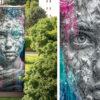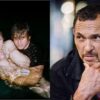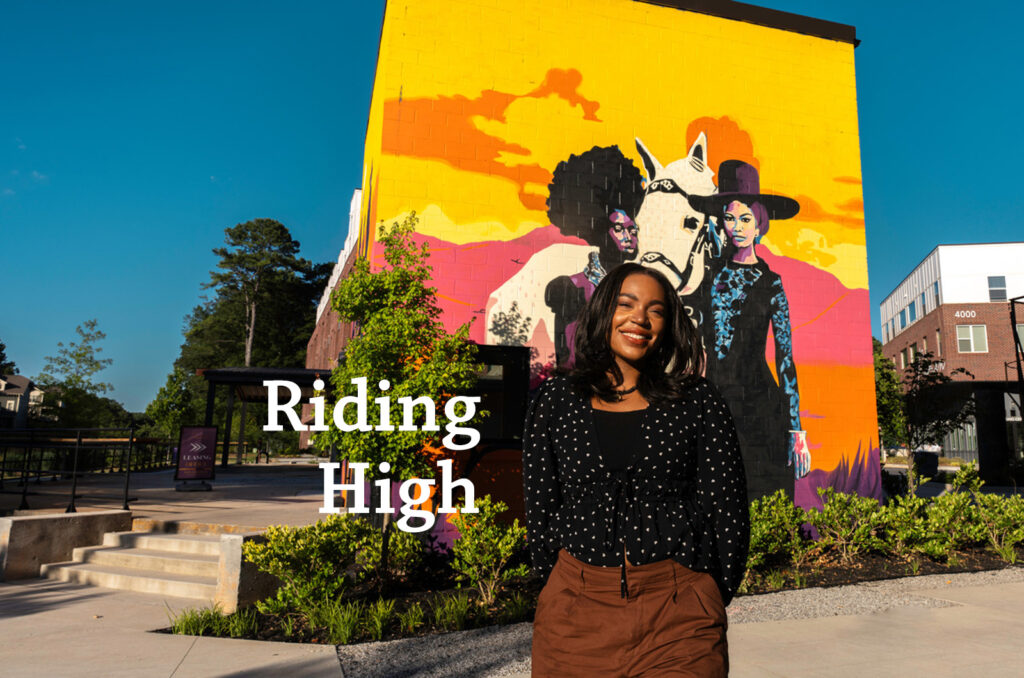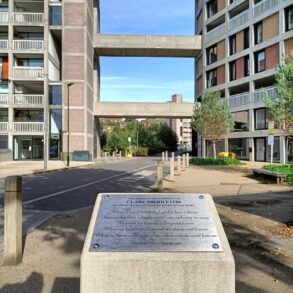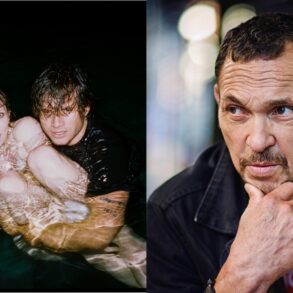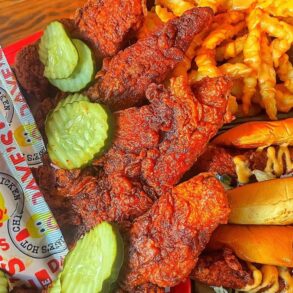Aziza Andre’ stands in front of her Beltline mural, RENASCENT. (Photo by Arshley Emile with permission from Atlanta Beltline Inc.)
Muralist Aziza Andre’ answered the Atlanta Beltline’s call to depict Black cowboys. Her mural pays homage to all of them.
::
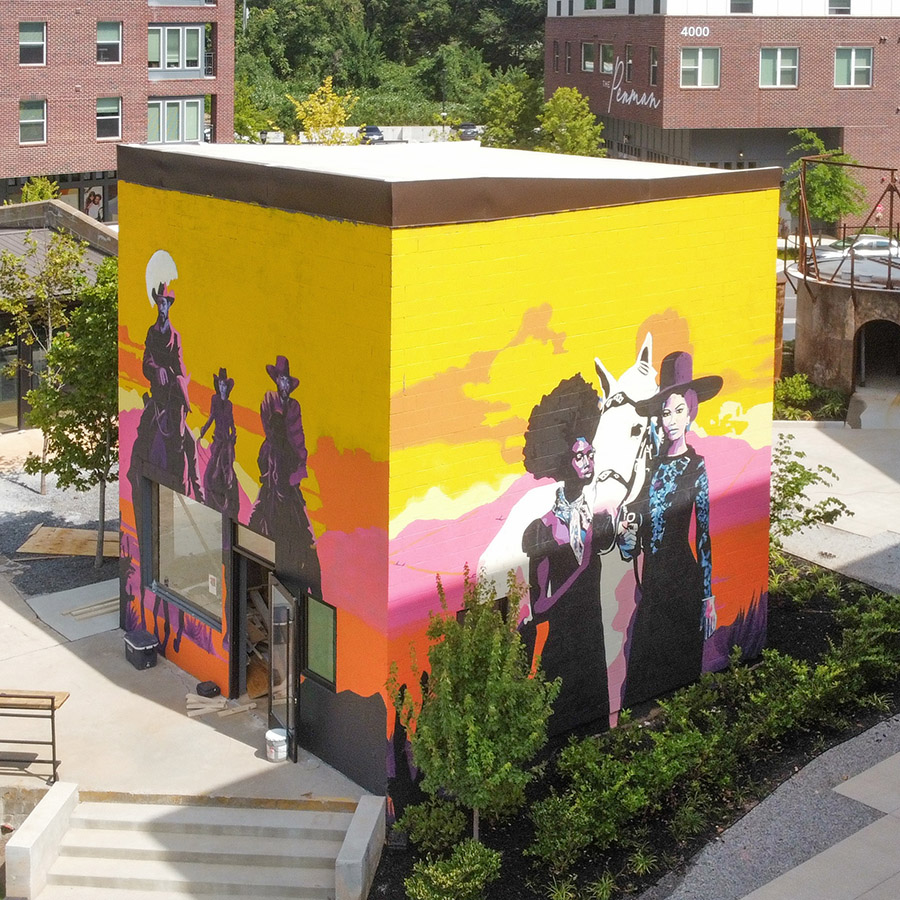
Did you know that 25% of cowboys were Black? Most people would never know it by watching the classic Western movies that many folks of a certain age grew up with.
Muralist and educator Aziza Andre’ and Atlanta Beltine Art have brought the stories of African American cowboys to life with a new mural titled RENASCENT at the Side Saddle Wine Saloon on the Beltline. “This is an incredible honoring of history that we are pleased to uplift in Grant Park, Ormewood Park and Boulevard Heights for all community members enjoying the Beltline Southeast trail,” said Amina Cooper, director of arts and culture for the Atlanta Beltline, in a statement. The Beltline is Atlanta’s 22-mile mixed-use linear park encircling the city, one of the largest such green space developments in the world.
::
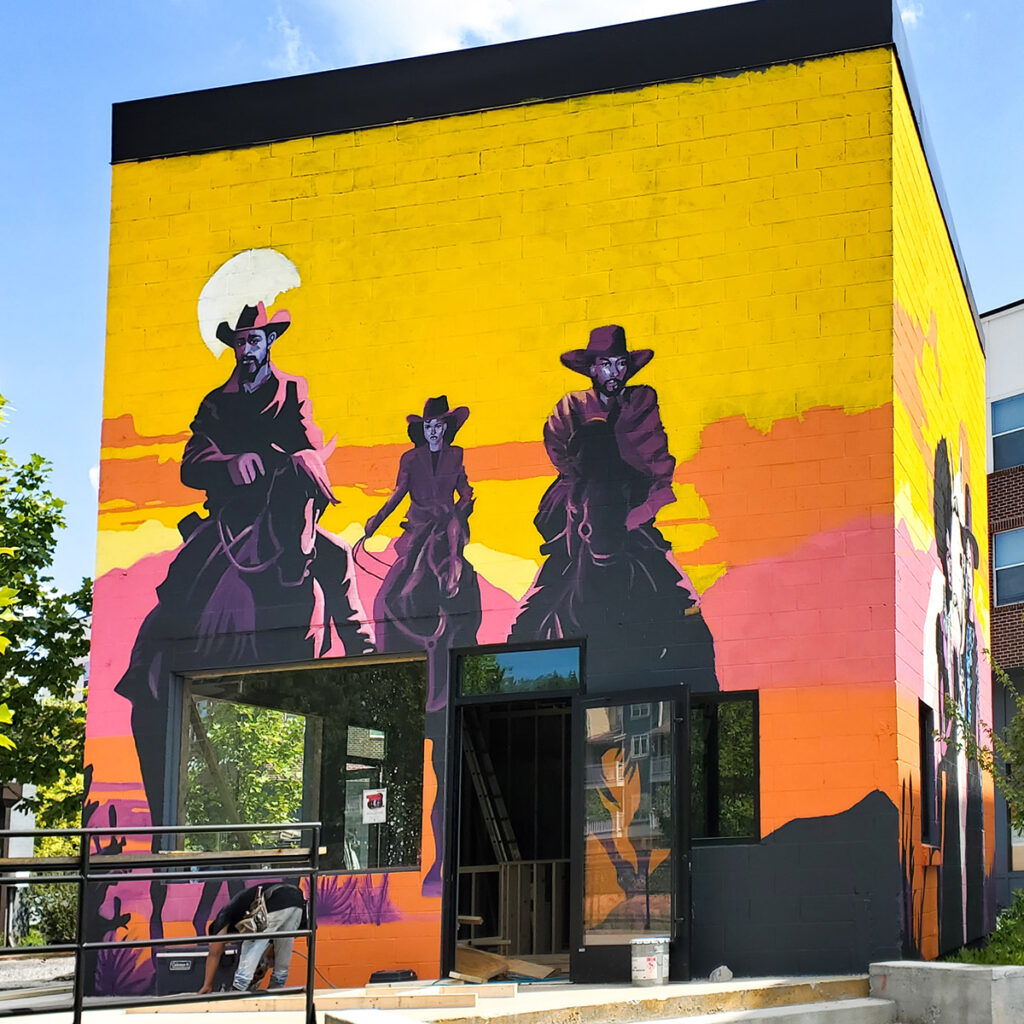
Aziza Andre’ grew up watching her comic book artist father draw Thor, Spiderman and Ironman for Marvel Comics. After constantly fielding her requests to draw various things for her, he eventually began to show Andre’ how to draw for herself. And Andre’s love for sequential art took off from there. While attending the Savannah College of Art and Design (SCAD) in Atlanta, Aziza also became interested in realism. Today her influences are a merger of comic-book style and realism.
After her graduation from SCAD in 2018, Andre’ established her studio, Content Creators Hive, in the city of East Point, where she taught college preparatory classes for students developing portfolios to apply to SCAD. She also taught younger students, one as young as 5.
Until 2023, she also taught Montessori art classes in her spare time at schools such as Parklane Elementary, KIPP Academy and the Suzuki School. In that year, Andre’ overcame her self-doubt and became a full-time muralist.
In Andre’s words: “I was tired of not trusting in something that I loved or something that others saw enjoyment from. I would do ABV Gallery shows and do the Drink & Doodle,” she said, referring to the popular art gallery and its party-like art events. “The response from others was so uplifting, and yet I was so hard on myself. I had to change my perspective and be kinder to myself. And give myself the best shot.”
Responding to a call for artists from Atlanta Beltline Art for a mural with the dual theme of African American Cowboys and Women and Horses, Andre’ was selected to execute the mural based on her research of the topics.
Here are the stories of some of the Black cowboys that Andre’ uncovered in her research and that inspired the mural:
Bose Ikard. Born into slavery in Mississippi in 1843, Ikard moved to Texas after the Civil War and worked as a cowboy and ranch hand. He became the trusted right-hand man of cattlemen Charles Goodnight and Oliver Loving. On cattle drives, Ikard served as a tracker and cowboy, fought against Comanche Native Americans and often carried thousands of dollars for deposit into a bank at the end of the drive. After his retirement from cattle driving, he moved to Parker County, Texas, and raised a family with his wife, Angeline. Ikard was honored with a Texas historical marker at his grave and induction into the National Cowboy & Western Heritage Museum — a school in Weatherford, Texas, was named after him. Ikard was the basis for Josh Deets, a character in the Pulitzer Prize-winning novel Lonesome Dove.
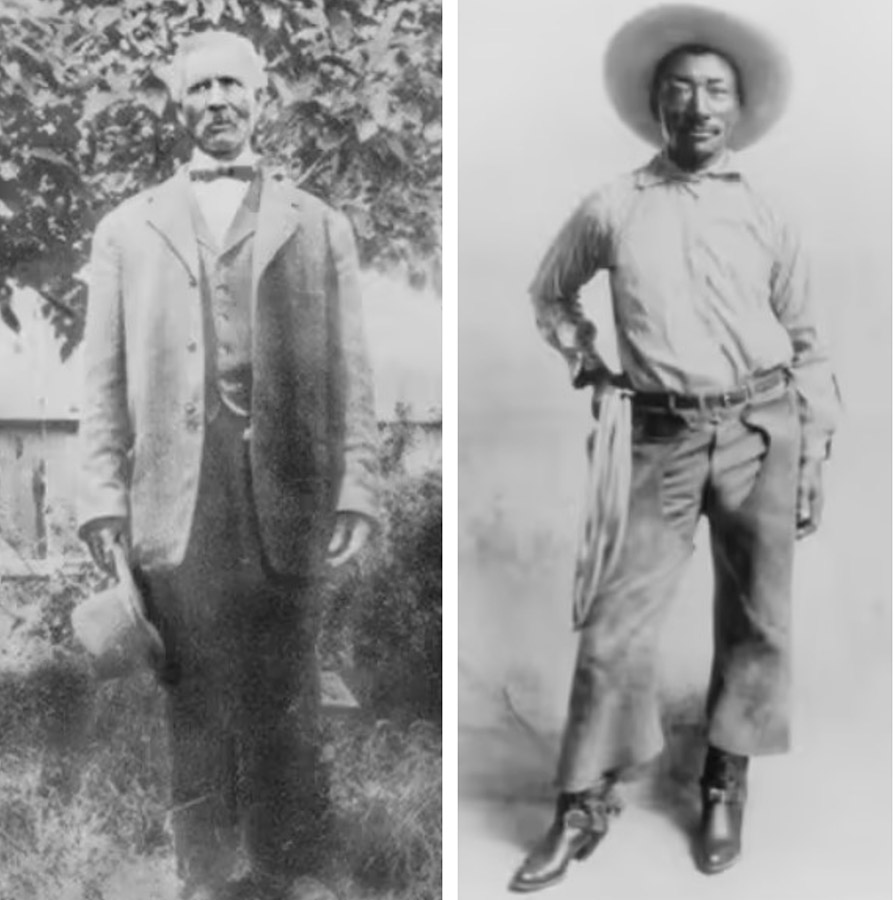
Bill Pickett. Bill Pickett was the inventor of the rodeo event called bulldogging, where a contestant grabs a steer by the horns and wrestles it to the ground. Born in 1870 in Jenks Branch, Texas, Picket’s ancestry included formerly enslaved and Cherokee Native American people. After completing a fifth-grade education, Pickett learned to ride horses and became a ranch hand and cowboy. Having gained a reputation for his riding feats, in 1888, Picket and his four brothers established The Pickett Brothers Bronco Busters and Rough Riders Association, a company providing horse-breaking and other cowboy services. Becoming one of the top performers on the rodeo circuit, Pickett demonstrated his bulldogging skills throughout Texas and Oklahoma, sharing the ring with Western luminaries such as Buffalo Bill, Will Rogers and Tom Mix. Many rodeos did not allow Black contestants, so Pickett often had to lean on his Native American heritage to gain entry. Pickett is featured in the National Cowboy & Western Heritage Museum and was inducted into the Pro Rodeo Hall of Fame in 1989.
Cleo Hearn. Born in Seminole, Oklahoma, in 1939, Cleo Hearn began his rodeo career at age 16. His mother was African American and his father was Seminole Native American. He was the first African American to win a rodeo scholarship to college. When he was drafted into the Army during the Kennedy administration, he was among the first African American members of the Presidential Honor Guard. Early in his rodeo career, African Americans were barred from participation in regular rodeos due to discrimination. Hearn’s persistence, superior calf-roping skills, large fan base and support from the other cowboys eventually forced the rodeo producers to integrate. In 1970, he was the first African American to win the calf-roping event at a major rodeo. Hearn established the Texas Black Rodeo in 1971 and later changed the name to Cowboys of Color Rodeo to promote inclusivity among both performers and fans. Hearn also had a 33-year-long career in sales and marketing with the Ford Motor Company.
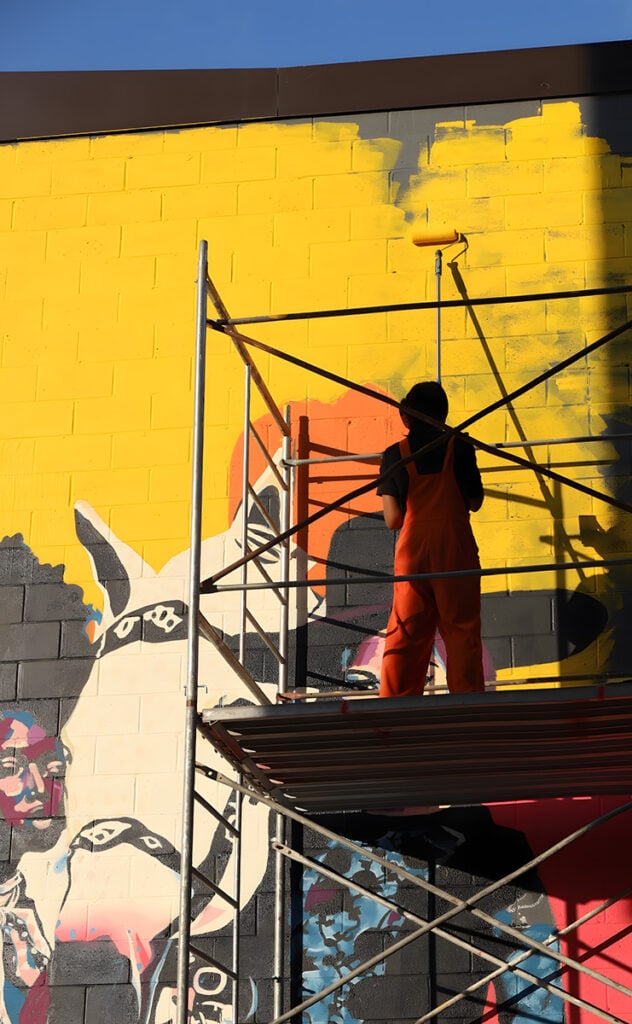
The title of Andre’s mural RENASCENT means rebirth or making something popular again. Because our memories of that period are filtered through black and white photographs, Andre’ intentionally included bright colors and a pop-art aesthetic. The mural has two parts. The left side presents African American cowboys — composites rather than specific historical figures. Nevertheless, she thought it might be fun to make one of the characters look like actor LaKeith Stanfield, who played the role of Cherokee Bill in The Harder They Fall, a Western movie with a mostly Black cast that took historical African American western figures such as Nat Love and Rufus Buck and dropped them into a fictional plot.
Making the central character a cowgirl was the suggestion of Kayla Bellman, the owner of Side Saddle Wine Saloon, whose building hosts the murals. The artist explains the right-hand side: “I know women are naturally more nurturing, so I wanted to showcase women next to a horse caring for and tending to it — and showing almost a vision of trust with one another. And then even small symbolisms, like one woman with gloves shows that she still tends to the land. She still does the work around the farm.”
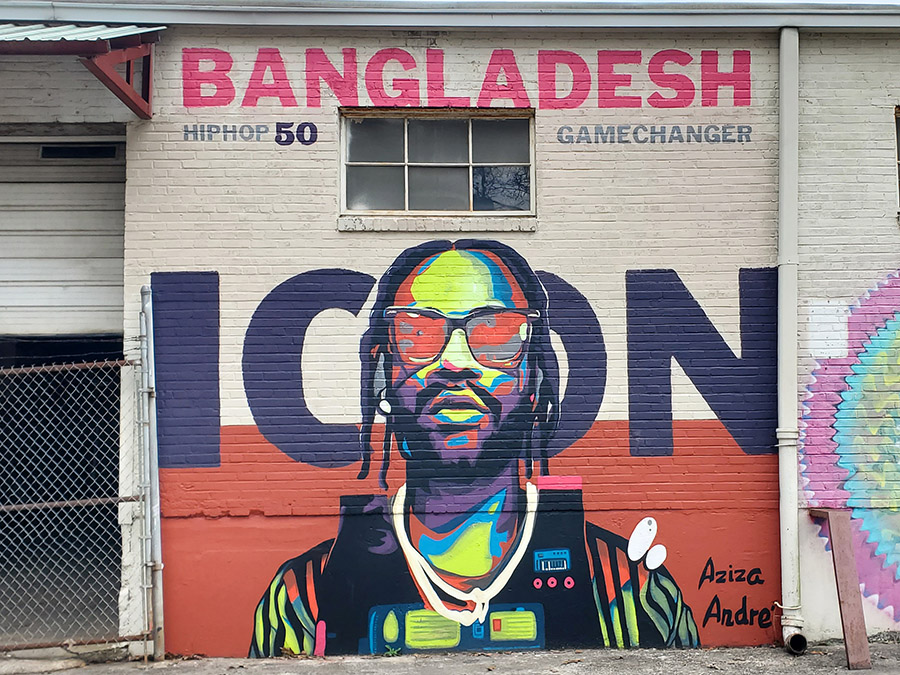
The horse is based on photographs of a friend’s horse. The women came from Andre’s imagination. Although not the artist’s intent, she was delighted when some viewers of the mural thought that one of the women resembled Beyoncé. Her recent Cowboy Carter album highlights under-represented contributions of African Americans to American musical and cultural history, mirroring the theme of the mural.
Andre’ has other murals around town, including one on Krog Street that features a portrait of record producer, songwriter and rapper Shondrae Lee Crawford, professionally known as Bangladesh. In 2022, Andre’ painted a wall for Forward, Warrior!! — an annual mural event — that featured a composite image of her grandmother and great aunt, highlighting her Portuguese background on her father’s side. She is currently putting the finishing touches on a new Forward, Warrior!! mural and will be participating in Babe Walls Chamblee in November.
::

Arthur Rudick created the Atlanta Street Art Map in 2017 after retiring from a successful career as an engineer with Eastman Kodak and the Coca-Cola Company. His first experience of art was seeing an Alexander Calder mobile as a child in the Pittsburgh airport. Rudick is ArtsATL’s street art expert and a regular contributor.
This post was originally published on this site be sure to check out more of their content.


